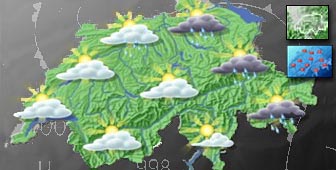Uncertainty “rains” in weather forecasting

Predicting tomorrow's weather remains an inexact science despite today's sophisticated technology. In Switzerland, the challenge of accurate forecasting is compounded by topography.
“The difficulty in a mountainous country like Switzerland is that almost every valley has its own special weather pattern,” said Felix Schacher, who has worked at the Swiss Meteorological Institute or MeteoSwiss for 28 years.
An Alpine phenomenon known as the “föhn” wind further complicates forecasting. The föhn occurs mainly in spring and autumn, when a depression north of the Alps sucks air from a summit ridge south of the Alps.
Moist and foggy air masses then usher clouds and heavy rain to the valleys and raise the air temperature.
“We know when the föhn starts to blow,” said Schacher, “but we don’t know exactly when it will end because sometimes it retreats and then it returns. It’s difficult to know where it will blow away the clouds and where it will rain.”
Around Switzerland, some 75 automatic weather stations measure about 25 weather elements such as temperature, wind and air pressure at ten-minute intervals. This information is then analysed by MeteoSwiss.
On any given day, the Institute says, the forecast is correct 85 per cent of the time. For a five-day forecast, the accuracy rate is about 70 per cent.
Historically, it has been important to know which way the wind will blow. The reaction of plants and animals has often been a key indicator of changing weather conditions.
“There are a whole range of signals which let us know what the weather is going to do,” said Aida Godel, who offers courses in plant behaviour.
“Plants act differently from area to area because the environment is different from towns to mountains to forest but any plant can tells us that it’s going to rain or be beautiful or dry. Pinecones are an obvious example, opening and closing when it’s wet.”
According to weather folklore, if geese fly high in the sky, you can expect bad weather, and if it is warm in November you should prepare for a bad winter. Professional forecasters say there is often an element of truth in this traditional wisdom.
“Sunset with a red sky does mean good weather on the following day,” said Schacher. “That’s because the red sky, which you see in the west, is a sign of dry air. In our region the weather normally comes from the west so when you have dry air there, it means good weather.
“Sunset in yellow colours indicates a lot of moisture in the air so when you have moist air in the west, then it’s quite possible that you will have some clouds and also some rain the next day.”
by Vincent Landon

In compliance with the JTI standards
More: SWI swissinfo.ch certified by the Journalism Trust Initiative
You can find an overview of ongoing debates with our journalists here. Please join us!
If you want to start a conversation about a topic raised in this article or want to report factual errors, email us at english@swissinfo.ch.